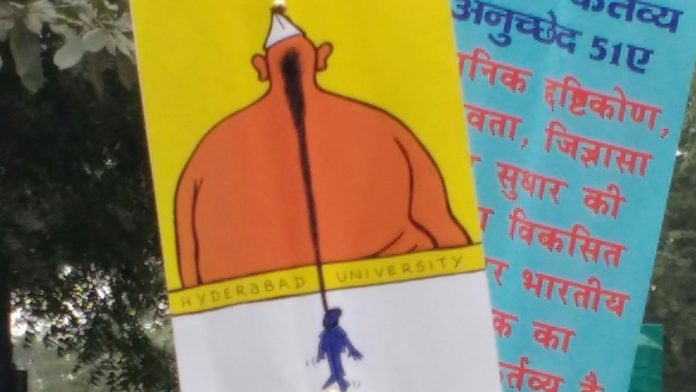The IITs have a long history of systematically othering Dalit students
The toxic belief that ‘quota students’ are innately less able than ‘mainstream students’ is at the heart of this caste-based exclusion.
YASHICA DUTT Updated: 17 February, 2019 1:24 pm IST
 A poster protesting the death of Rohith Vemula | Simrin Sirur/ThePrint
A poster protesting the death of Rohith Vemula | Simrin Sirur/ThePrintAll these universities seem to be following the same playbook on how to exclude Dalits. The academic performance of the students seems to be less important than their lower caste status. Ragging, institutional bullying and lack of support for Dalit students causes many of them to commit suicide, and discourages other Dalits from applying to these important centres of learning, leading them to be excluded from these fields. This sends a clear signal to young Dalit aspirants that these prestigious colleges have no place for them, regardless of what the reservation policy dictates. The toxic belief that ‘quota students’ are innately less able or talented than ‘mainstream students’ is at the heart of this exclusion.
The IIT-JEE exam, which aims to test a student’s aptitude for engineering, is not only tough but also vastly different from the central or state board exams that high school students clear in school. The problems challenge logic and theory in a way that makes it almost impossible for anyone who is unfamiliar with its ‘code’ to solve them. The coaching institutes, including the one that I attended, teach the patterns, codes and techniques to finish the examination paper in three hours. About 82 per cent of Indian students either take additional coaching for IIT-JEE and other science-based competitive exams at the numerous coaching institutes that dot every small and big town or directly go to Kota, Rajasthan, to study at one of the 150 ‘cram schools’, which pretty much guarantee you a spot on the list if you are admitted and follow their instructions. Even local coaching is expensive, costing about Rs 2,000-3,000 per month nearly sixteen years ago in 2001- 03 when I took these classes.
The fees for the Kota schools can go up to Rs 1 lakh a month, which doesn’t include the cost of living—making it prohibitively expensive for students from marginalized backgrounds. It’s not that students can’t clear these exams without coaching; many SC/ST students in fact do, but since they come from marginalized backgrounds, they lack other support structures.
That, along with their government school education, often leads many SC/ST/OBC students to drop out or be expelled for low grades. In 2015, 90 per cent of the students that IIT Roorkee dismissed on account of low grades were SC/ST/OBC. Added to this is the distress, discrimination and systemic failure that ‘quota students’ face at these prestigious institutions. Nearly 80 per cent of student suicides in IITs till 2011 were of Dalit students.
IIT students have a long history of opposing constitutional reservation and several members of YFE in 2006 were from its various colleges. Many used the IIT Roorkee dropouts incident to argue that ‘quota students’ are inherently talentless and don’t belong in the colleges, instead of examining the conditions that led to their dropping out. IITs across the country admit a disproportionately high number of upper-caste students in the general category, which Harvard-based anthropologist Ajantha Subramanian argues isn’t as casteless or ‘meritorious’ as it seems. Using IIT Madras as a case study, she examines how when the number of European engineers in India decreased at the beginning of the twentieth century, Tamil Brahmins were the single largest group in Madras Presidency to replace them. They also filled over 70 per cent seats in regional engineering institutes despite forming only 3 per cent of the population, and were disproportionately represented in most modern professions along with other upper castes. At IIT Madras, not only the students but also the faculty are overwhelmingly upper caste, with 464 professors drawn from the ‘general category’, 59 OBCs, 11 SCs, and 2 STs. She argues that association of ‘general category’ with merit is biased because the students from that category are assumed to be upper caste. During her interviews with several former IIT students, she discovered that many believed that while general category students got bad grades because they were ‘having fun’, reserved category students simply didn’t have the intellectual capability to do well. Unsurprisingly, the administration supports that idea, especially former director P. V. Indiresan who believed that ‘the talented’ upper castes deserved ‘rights of their own’ compared to the ‘socially deprived’ who demanded special privileges.
The idea that upper castes are inherently ‘talented’ while the reserved category SC/ST/OBC students are meritless is as hollow as it is casteist. In an anonymous study on the state of female Dalit students in a prestigious Indian university, PhD candidates and research fellows complained that they were discouraged from applying to the generous Rajiv Gandhi National Fellowship for SC/ST students. They were told that they didn’t ‘deserve free fellowships’. And the faculty impose their casteist ideas in the universities in many ways. The University of Hyderabad’s ‘Brahmin well’ which was dug in the 1980s for Professor V. Kannan is a ridiculous example of that. Kannan only allowed other upper-caste students and professors to access it and lower-caste students and faculty couldn’t come anywhere near it till he retired in 2014. Upper-caste professors not only discriminate against their lower-caste colleagues but also question their ‘merit’ and their right to their careers. Professor Vasant Tarade, a former principal of Mumbai’s Sydenham College, recalled that a Brahmin professor refused to use his chair after he retired.
Years of being accused of caste-based discrimination have had some impact and institutes have created some systems to support the reserved category students. The AIIMS website informs us that the campus has a SC/ST grievance cell, while Jawaharlal Nehru University (JNU) has a personalized academic support system and the IITs have English language classes to help students from vernacular language backgrounds. Yet, as Professor Thorat notes, these institutes ‘lack the will to implement them in full’. Universities and colleges should be centres for learning new ideas and questioning the status quo. Instead, they become places of discrimination, exclusion and institutional harassment. Young minds are bred with hate, ready to assert their caste hierarchy over the next generation. Students are not taught why reservation is essential for those from the lower castes, who have been excluded from education, art, culture and even owning property, to reach a somewhat level playing field. Without reservation, Dalits will remain on the fringes, unable to access even the most basic opportunities.

IIT students have a long history of opposing constitutional reservation and several members of YFE in 2006 were from its various colleges. Many used the IIT Roorkee dropouts incident to argue that ‘quota students’ are inherently talentless and don’t belong in the colleges, instead of examining the conditions that led to their dropping out. IITs across the country admit a disproportionately high number of upper-caste students in the general category, which Harvard-based anthropologist Ajantha Subramanian argues isn’t as casteless or ‘meritorious’ as it seems. Using IIT Madras as a case study, she examines how when the number of European engineers in India decreased at the beginning of the twentieth century, Tamil Brahmins were the single largest group in Madras Presidency to replace them. They also filled over 70 per cent seats in regional engineering institutes despite forming only 3 per cent of the population, and were disproportionately represented in most modern professions along with other upper castes. At IIT Madras, not only the students but also the faculty are overwhelmingly upper caste, with 464 professors drawn from the ‘general category’, 59 OBCs, 11 SCs, and 2 STs. She argues that association of ‘general category’ with merit is biased because the students from that category are assumed to be upper caste. During her interviews with several former IIT students, she discovered that many believed that while general category students got bad grades because they were ‘having fun’, reserved category students simply didn’t have the intellectual capability to do well. Unsurprisingly, the administration supports that idea, especially former director P. V. Indiresan who believed that ‘the talented’ upper castes deserved ‘rights of their own’ compared to the ‘socially deprived’ who demanded special privileges.
The idea that upper castes are inherently ‘talented’ while the reserved category SC/ST/OBC students are meritless is as hollow as it is casteist. In an anonymous study on the state of female Dalit students in a prestigious Indian university, PhD candidates and research fellows complained that they were discouraged from applying to the generous Rajiv Gandhi National Fellowship for SC/ST students. They were told that they didn’t ‘deserve free fellowships’. And the faculty impose their casteist ideas in the universities in many ways. The University of Hyderabad’s ‘Brahmin well’ which was dug in the 1980s for Professor V. Kannan is a ridiculous example of that. Kannan only allowed other upper-caste students and professors to access it and lower-caste students and faculty couldn’t come anywhere near it till he retired in 2014. Upper-caste professors not only discriminate against their lower-caste colleagues but also question their ‘merit’ and their right to their careers. Professor Vasant Tarade, a former principal of Mumbai’s Sydenham College, recalled that a Brahmin professor refused to use his chair after he retired.
Years of being accused of caste-based discrimination have had some impact and institutes have created some systems to support the reserved category students. The AIIMS website informs us that the campus has a SC/ST grievance cell, while Jawaharlal Nehru University (JNU) has a personalized academic support system and the IITs have English language classes to help students from vernacular language backgrounds. Yet, as Professor Thorat notes, these institutes ‘lack the will to implement them in full’. Universities and colleges should be centres for learning new ideas and questioning the status quo. Instead, they become places of discrimination, exclusion and institutional harassment. Young minds are bred with hate, ready to assert their caste hierarchy over the next generation. Students are not taught why reservation is essential for those from the lower castes, who have been excluded from education, art, culture and even owning property, to reach a somewhat level playing field. Without reservation, Dalits will remain on the fringes, unable to access even the most basic opportunities.

This excerpt was taken with permission from the book ‘Coming Out as Dalit: A Memoir’ by Yashica Dutt. It was published by Aleph.